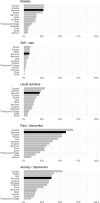EQ-5D-5L Slovenian population norms
- PMID: 33028345
- PMCID: PMC7542912
- DOI: 10.1186/s12955-020-01584-w
EQ-5D-5L Slovenian population norms
Abstract
Background: The study aims to present Slovenian EQ-5D-5L population norms for different age and gender subgroups that can be used as reference values in future studies concerning health status. The secondary aim is to compare those norms with population norms from some other countries in Europe and elsewhere.
Methods: The cross-sectional survey was conducted between November 2019 and February 2020 via online panel. 1071 adults aged 18+ were included in the survey. The general population was sampled using quota sampling in terms of age, gender, and NUTS2 region. In the study, the EQ-5D-5L Slovenian online version was used. Descriptive statistics was used to present health status by age groups and genders for the EQ-5D-5L descriptive system, EQ VAS and the EQ-5D-5L index score. The latter was derived from Slovenian EQ-3D-3L tariff, transformed to five levels using the crosswalk methodology.
Results: The mean EQ VAS score in the Slovenian population was 79.9, mean utility index was 0.808. 28.2% of the population did not have problems on any dimension and 3.9% of the population had problems on all dimensions. Persons residing in Western Slovenia had, on average, 0.016 higher utility score, compared to Eastern Slovenia. Effect of gender was not significant. Age was negatively associated with both utility index and EQ VAS score. Education was positively correlated to health status. Problems on dimensions were generally increasing with age, except for anxiety/depression dimension, where youngest group (ages 18-29) reported more anxiety/depression compared to older counterparts. Self-reported anxiety/depression was more pronounced in women.
Conclusions: Similarly to other countries, the health generally deteriorates with age, except for the anxiety/depression dimension where the share of respondents reporting no problems was lowest in the youngest age group. The open question for the future remains, whether population norms from this online sample differ significantly from the actual EQ-5D-5L health status data of the Slovenian general population.
Keywords: EQ VAS; EQ-5D-5L; Health status; Patient-reported outcomes; Population norms; Reference values.
Conflict of interest statement
VPR is a member of the EuroQol Group. MO declare no competing interests.
Figures






Similar articles
-
Population norms for the EQ-5D-3L and EQ-5D-5L in Romania.Health Qual Life Outcomes. 2023 Jul 29;21(1):80. doi: 10.1186/s12955-023-02144-8. Health Qual Life Outcomes. 2023. PMID: 37507760 Free PMC article.
-
Health-related quality of life measured using the EQ-5D-5L: South Australian population norms.Health Qual Life Outcomes. 2016 Sep 20;14(1):133. doi: 10.1186/s12955-016-0537-0. Health Qual Life Outcomes. 2016. PMID: 27644755 Free PMC article.
-
US population norms for the EQ-5D-5L and comparison of norms from face-to-face and online samples.Qual Life Res. 2021 Mar;30(3):803-816. doi: 10.1007/s11136-020-02650-y. Epub 2020 Oct 6. Qual Life Res. 2021. PMID: 33025373 Free PMC article.
-
Methodological similarities and variations among EQ-5D-5L value set studies: a systematic review.J Med Econ. 2022 Jan-Dec;25(1):571-582. doi: 10.1080/13696998.2022.2066441. J Med Econ. 2022. PMID: 35416095
-
Health-Related Quality of Life in Patients With Different Diseases Measured With the EQ-5D-5L: A Systematic Review.Front Public Health. 2021 Jun 29;9:675523. doi: 10.3389/fpubh.2021.675523. eCollection 2021. Front Public Health. 2021. PMID: 34268287 Free PMC article.
Cited by
-
Clinical outcomes of arthroscopic and navigation-assisted two tunnel technique for coracoclavicular ligament augmentation of acute acromioclavicular joint dislocations.BMC Musculoskelet Disord. 2021 Jun 9;22(1):528. doi: 10.1186/s12891-021-04406-2. BMC Musculoskelet Disord. 2021. PMID: 34107940 Free PMC article.
-
EQ-5D-5L Portuguese population norms.Eur J Health Econ. 2023 Dec;24(9):1411-1420. doi: 10.1007/s10198-022-01552-9. Epub 2023 Jan 11. Eur J Health Econ. 2023. PMID: 36630005 Free PMC article.
-
Population Norms for SF-6Dv2 and EQ-5D-5L in China.Appl Health Econ Health Policy. 2022 Jul;20(4):573-585. doi: 10.1007/s40258-022-00715-2. Epub 2022 Feb 8. Appl Health Econ Health Policy. 2022. PMID: 35132573
-
EQ-5D-Y Population Norms for Japanese Children and Adolescents.Pharmacoeconomics. 2021 Nov;39(11):1299-1308. doi: 10.1007/s40273-021-01063-0. Epub 2021 Jul 22. Pharmacoeconomics. 2021. PMID: 34292524 Free PMC article.
-
Norms for the EQ-5D-5L among the general adult population in Alberta, Canada.Qual Life Res. 2025 Jan;34(1):219-230. doi: 10.1007/s11136-024-03804-y. Epub 2024 Nov 2. Qual Life Res. 2025. PMID: 39487883 Free PMC article.
References
MeSH terms
Grants and funding
LinkOut - more resources
Full Text Sources

